Posted by Anita on 02.14.08 12:03 AM
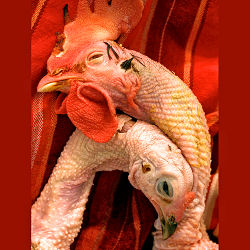 Have I mentioned lately how much I love the farmers who keep us fed? Even when I’ve done something utterly short-sighted, they managed to swoop in and save me from my own culinary stupidity.
Have I mentioned lately how much I love the farmers who keep us fed? Even when I’ve done something utterly short-sighted, they managed to swoop in and save me from my own culinary stupidity.
Last week, Cameron came up from the basement and announced that somehow we’d run out of chicken stock. “That’s impossible,” I replied. “We had gallons…” A quick trip down the stairs showed that he was right. GULP!
Given that our source of pastured, local chickens dried up before Thanksgiving and that I didn’t really do anything to prepare for this eventuality other than making my usual batches when the bone-bag filled up, I guess I am lucky to have made it this far into winter without running dry. But how could we survive months without a local source of one of our most necessary staples?
After three grocery stops, I finally managed to find local, organic chicken backs. Unfortunately, the Rosie chicken parts that Whole Foods carries come from factory organic farms — they’re local, technically, and ‘free range’, technically, but they’re not really my idea of humane, ethical meat. Unless I wanted to go without stock until spring, I was going to have to choose the lesser of various evils. I went home chickenless and annoyed at my lack of planning.
Two days later, whatever deity watches over locavores and other fools swooped in to save my bacon:
From: Cara, Marin Sun Farms
Subj: Range Hens & Roosters
Range hens and range roosters will be offered this weekend at our Farmer’s Markets and Butcher Shop in Point Reyes Station on a first come first serve basis.
I could hardly believe my eyes: pastured chickens, in February? We’ll take two, please. They weren’t cheap — one rooster and one hen tapped out our protein budget for the week (and then some). But they were there, and that’s all that mattered to me and the other folks who swarmed the stand as the market opened.
It turns out that these sturdy birds were no spring chickens [groan!]. Happy by-products of Marin Sun Farms’ egg production, they’re easily double the size of the birds we buy in the spring and summer.
If you think you’re smugly immune to the grim realities of chicken butchery after a summer of dainty heads and tiny feet, you’ve got another thing coming when your supper greets you with an open-eyed stare. And cutting big birds into parts is no trauma-free event, either. Like most other creatures, chickens’ bones and tendons firm up as they mature. The simple shears-and-boning-knife operation required to part out a 3-month-old fryer is a walk in the park compared with the hatchet-job required to take apart a full-grown rooster — and I have the torn-up hands to prove it.
Even if these birds hadn’t been freakishly large, their long, narrow breasts would be a dead giveaway. Barely more than one serving of white meat per bird, these bony chests make an almost-comical sight paired with long, rangy legs. “They look like chickens that tried out for the basketball team,” quipped Cameron.
Mature fowl are best cooked low and slow; one of the MSF farmers was telling folks at the stand that he’d made an exploratory batch of fried chicken, just to see, and… well, no surprise, he didn’t recommend anything but the soup pot or a long, slow stew for any of these tough old birds. (See how many American idioms come from our agricultural roots?)
Of course, any grandma will tell you that modern factory chicken doesn’t taste like it did in the olden days, and much of that has to do with the fact that today’s chickens are slaughtered well before they’re adolescent, much less geriatric. As early as the 1960s, full-fledged stewing chickens were hard enough to come by that even Julia was calling for a measly 2-1/2 to 3-pound fryer for her coq au vin.
Thankfully, we found a lovingly thorough recipe — avec un vrai coq — in our new copy of the River Cottage Meat Book, Hugh Fearnley-Whittingstall‘s ode to sustainable eating in all its carnivorous glory. “They might be scrawny and … on the tough side” says our man Hugh, “But with a diet comprising largely natural forage, by god they’d be tasty.”
Not that I’d ever gainsay a meat maven like Mister F-W, but old-man rooster was definitely an acquired taste, even if you’re used to the “more-chickeny” flavors of pastured meat. Don’t get me wrong: The flavor it lent to the sauce was truly unparallelled — an unctuous, meaty taste that felt in all ways more like beef stew than anything poultry based. As for the meat itself, I liked it when I ate it in the small pieces that flecked the sauce, but the larger chunks were a tad too gamey for my girly palate. Cameron, however, gobbled his bowl while making little moaning noises, so chacun à son goût. For the leftovers, I shredded the meat and put it back in the sauce; served over pasta like a ragu, the flavor was perfect.
Oh, and the backs, wings, feet, heads, and other sundry bits made 12 glorious quarts of golden stock. Our freezer is chock-full of delicious homemade goodness once more. And if that’s not true love, baby, I don’t know what is.


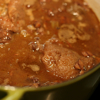

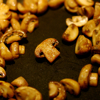
Coq au Vin
— adapted from the River Cottage Meat Book
1 stewing chicken, ideally a farmyard rooster*
1/4 cup butter
1T olive oil
8 ounces pancetta or bacon, cut into large chunks
8 ounces onions, cut into quarters
1/3 cup all-purpose flour, seasoned with salt and pepper
4 oz brandy
2 cups red wine
2 cups chicken stock
bouquet garni of parsley stalks, bay leaf, and thyme
4 celery stalks, cut into 1-1/2-inch lengths
4 garlic cloves, smashed
2 cups canned chopped tomatoes
—
6 to 8 carrots, cut into 1-1/2-inch pieces
1/2 pound white button mushrooms, halved or quartered depending on size
4 to 8 ounces small onions (such as cippolini or pearl), peeled and trimmed
Preheat the oven to 250°F. Cut the chicken into 4 serving pieces, reserving the neck, back, and wingtips (and feet and head, if available) for stock. Heat the butter and oil in a large ovenproof casserole. Fry the bacon pieces in the butter/oil until browned, and remove to a plate with a slotted spoon. Lightly brown the onions in the same pan, and likewise remove them to the plate.
In a paper bag, shake the chicken pieces with the seasoned flour until coated, tapping them against the side of the bag to remove any excess. Brown the dredged chicken in the bacon-butter-oil, working in batches if necessary so as not to crowd the pan, and turning to brown all sides properly. If you’ve worked in batches, return all the chicken parts to the casserole. Pour the brandy over the chicken and (very, very carefully) flame it with a long-handled match. When the flames die down, remove the chicken to the plate with the onions and bacon.
Add the red wine to the casserole, scraping the bottom and sides of the pan to remove any stuck-on bits. Add the stock to the pan and heat to a simmer. Then return the bacon, onions, and chicken to the pan along with the herbs, celery, garlic, and tomatoes. Bring to a gentle simmer. Cover and cook in the oven for 2 to 2-1/2 hours (more like 1-1/2 hours for a younger chicken) until the meat is completely tender.
When you’re within a half-hour of serving time, saute the mushrooms in a bit of olive oil. Please resist the temptation to salt them until they are browned and delicious — you will get a much firmer, tastier mushroom. Meanwhile, in a small frying pan, gently cook the carrots and onions in a shallow layer of water, turning them occasionally and removing them from the pan when they’re just cooked through.
When the chicken is ready, check the consistency of the sauce. If you have a very tight-fitting casserole lid, and/or a wimpy chicken, you may need to reduce the liquid by as much as half of its volume. (Leave the chicken and vegetables in the covered casserole, and reduce the sauce in a separate pan.) Once your pan sauce is thick enough to coat the back of a spoon, put everything together — chicken, vegetables, mushrooms, and sauce — and bring back just to a gentle simmer.
Adjust seasonings to taste, and serve with your favorite mashed potatoes or herbed new potatoes.
* If no roosters are available, HF-W recommends substituting the legs, wings, neck, and giblets of a good free-range turkey, leaving the breast to be roasted another day.
Dark Days challenge, locavore, recipes, shopping
26 Comments »




Posted by Anita on 02.08.08 12:01 PM
 The fall that Cameron and I started dating was a brutal season. Everyone we knew seemed to have one of those colds that catches you in its grip and refuses to let go. The sound of coughing and sneezing was everywhere, and it seemed like the whole city of San Francisco had a red nose and bags under its eyes.
The fall that Cameron and I started dating was a brutal season. Everyone we knew seemed to have one of those colds that catches you in its grip and refuses to let go. The sound of coughing and sneezing was everywhere, and it seemed like the whole city of San Francisco had a red nose and bags under its eyes.
That was the first time — though certainly not the last — that I heard Cameron describe his favorite cold remedy, the Two-Hat Cure: “Grab a bottle of whiskey and put your hat at the foot of the bed. Get into bed, pile the blankets high, and take a good long pull of whiskey. Keep drinking until you see two hats.” It may not cure your cold, exactly, but you definitely won’t care.
In all seriousness, medical experts tell us to exercise caution when drinking while under the weather: Alcohol can dehydrate your already overtaxed system, and many over-the-counter medications are downright dangerous with booze. But even our grandmothers knew that there’s definitely a time and a place for the medicinal powers of whiskey. Especially when combined with sugar or honey, it has the power to calm coughs and soothe raspy throats. Adding warm water or juice helps adjust for the dehydration factor and alleviate sinus congestion. And its sedative effects can give over-exhausted bodies the push they need to get some much-needed Z’s.
In short, a Hot Toddy is just the ticket when you’re feeling under the weather. It’s one of those highly adaptable recipes — CocktailDB alone lists more than 20 variations — but nearly every Toddy follows a simple formula: Combine a shot of (usually brown) liquor and a sweetener (sugar, honey); fill the glass with warm water (or cider, juice, etc.), and garnish with complementary aromatics; traditional choices include lemon wedges, orange peel, and warm spices like cinnamon, nutmeg, or cloves. The less-commonly-seen cold toddy follows the same basic model, but is served in a rocks glass over ice.
 While spending the last two-plus weeks battling a world-class cold and its aftereffects — and in the spirit of month’s edition of Mixology Monday hosted by the fine Mr. Patrick at Jimmy’s Cocktail Hour — I’ve been exploring a number of variations in the key of Toddy. I started with bourbon, honey, and orange peel; I sampled brandy, lemon juice, and sugar; I tried rum with brown sugar, cloves, and nutmeg. But my favorite flavor combo includes a strong slug of 100-proof applejack, sweetened with unbleached sugar cubes and garnished with a stick of Mexican cinnamon and star anise. After all, if an apple a day keeps the doctor away, I’m all for it.
While spending the last two-plus weeks battling a world-class cold and its aftereffects — and in the spirit of month’s edition of Mixology Monday hosted by the fine Mr. Patrick at Jimmy’s Cocktail Hour — I’ve been exploring a number of variations in the key of Toddy. I started with bourbon, honey, and orange peel; I sampled brandy, lemon juice, and sugar; I tried rum with brown sugar, cloves, and nutmeg. But my favorite flavor combo includes a strong slug of 100-proof applejack, sweetened with unbleached sugar cubes and garnished with a stick of Mexican cinnamon and star anise. After all, if an apple a day keeps the doctor away, I’m all for it.





Hot Apple Toddy
1oz to 2oz applejack (or brandy, whiskey, etc.)
1 to 2 natural sugarcubes
hot water
Garnishes: cinnamon stick (preferrably Mexican canela), star anise, or other warm spices; lemon wedge, apple slice, orange peel, etc.
Place the sugar and applejack in the bottom of an Irish coffee mug. Add hot water to fill, stir to dissolve sugar, and garnish as desired.
Drink of the Week, drinks, Mixology Monday, recipes
11 Comments »




Posted by Anita on 02.06.08 11:10 PM
 You’d be forgiven for thinking that locavore eating in the dead of winter means a limited palate of kale-green, potato-brown and cauliflower-beige. But, much to our very pleasant surprise, we’ve been cooking up a colorful assortment of oranges, pinks, purples… and even reds.
You’d be forgiven for thinking that locavore eating in the dead of winter means a limited palate of kale-green, potato-brown and cauliflower-beige. But, much to our very pleasant surprise, we’ve been cooking up a colorful assortment of oranges, pinks, purples… and even reds.
I’ve told you about two of the drinks at our cocktail soirée, but here’s a little secret about the nibbles we served: Everything was at least 90% local, and most of it came from entirely within our 100-mile radius.
The prettiest plate of the night was Cameron’s gorgeous tower of tiny Martha-inspired canapes: roast beef and horseradish on herb bread, and two different kinds of smoked salmon with mustard-fennel sauce on rye. An assorted platter of Fatted Calf pâtés and sausages took their place beside a trio of locally produced mustards. The crudite plate included too-cute-to-eat baby carrots, fractal-icious romanesco, and blushing breakfast radishes. A batch of pesto-filled pastry pinwheels, a spicy dip of Rancho Gordo black beans, and a platter of Northern California cheeses rounded out the savory stuff. On the sweet side, a batch of Earl Grey-scented tea cookies caused such a stir that three different guests asked for the (ridiculously easy) recipe.
Much as I adored the tea cookies, my favorite new party recipe isn’t a recipe at all. We cut a big bagful of Happy Quail piquillo peppers in half — yes, we had local peppers in January! — removed the seeds, and stuffed them with a mixture of Fatted Calf chorizo and Acme breadcrumbs. A few minutes under the broiler and we had the most popular hors d’oeuvre of the evening. I can hardly wait until next season to try it again!
After a party like that, that last thing we wanted to do was cook. As the month wound down, we hit up some of our favorite restaurants to see what their midwinter menus had in store. Nopa served us yet another scrumptious supper courtesy of our local farmers: we split an order of goat cheese fondue, followed by a grass-fed burger for Cameron and grass-fed shortribs for me. A few days later we ended up with friends at The Alembic, where we shared local lamb sliders and a sinful order of truffled mac-and-cheese made with Mt. Tam and Serena — two of our favorite Northern California cheeses.
With Dark Days like these, it’s hard to feel deprived.


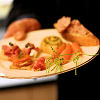
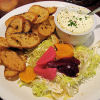

Dark Days Ticker — January 16-30
– Dark Days dinners at home: 7 (out of 16), plus the party food
– Locavore dining-out: Alembic, Nopa, Range
– New recipes: Pesto pinwheels, chorizo-stuffed peppers, Earl Grey tea cookies
– Old faves: Mom’s quiche Lorraine, Julia Child’s beef stew
– Freezer fodder: Linguine Bolognese, chicken & dumplings
New (to us) local items
– Cap’n Mike’s smoked salmon — red and white varieties
– Piper-Sonoma Brut and Blanc de Noirs sparkling wine
– Capellino pesto in a tub (made in SF!)
– Bellwether Farms’ pecorino-style Pepato
– La Clarine Farm’s Sierra Mountain goat Tomme
– Eatwell Farm‘s romanesco
– Happy Quail Farms piquillo peppers (last of the season!)
– Local mustards from Made in Napa Valley, Mendocino Mustard and Narsai’s
Dark Days challenge, entertaining, locavore
11 Comments »




Posted by Anita on 02.01.08 6:54 AM
 My friend Sam brought us the most fabulous hostess gift: A vintage copy of Robert Vermiere’s Cocktails – How to Mix Them. It’s a little pocket-sized gem of a book, best known as one of the first sources for the Sidecar. (It’s possible Harry MacElhone’s ABCs of Mixing Cocktails beat Vermiere to the punch, but both sport a 1922 publication date so I’m content to call it a draw.)
My friend Sam brought us the most fabulous hostess gift: A vintage copy of Robert Vermiere’s Cocktails – How to Mix Them. It’s a little pocket-sized gem of a book, best known as one of the first sources for the Sidecar. (It’s possible Harry MacElhone’s ABCs of Mixing Cocktails beat Vermiere to the punch, but both sport a 1922 publication date so I’m content to call it a draw.)
I spent a happy afternoon flipping through the book’s age-darkened pages, amusing myself by deciphering the spidery notes in its margins scribbled by some long-ago drinker. It’s a treasure trove of possibilities.
Alas, the spirit is willing, but the flesh is weak.
I’ve had no desire whatsoever to experiment, much less to imbibe. Like nearly everyone else in my area code, I’ve been slammed by the bug that doctors are calling the Super Cold. I’ll spare you the litany of disgusting symptoms and secondary infections, but I feel compelled to brag that I made a nurse say “Eeeww!”
After a trip to the emergency room and enough prescriptions to supply a small pharmacy, I’m finally back among the living. I even managed to have a drink or two last night. But frankly, the idea of tinkering with proportions or doing a lot of in-depth historical research is still making me a little woozy. Luckily, there were enough great bubbly-based drinks flowing at the Cockails and Canapes party that I won’t have to leave you in the lurch this week. Here’s one of my favorites:



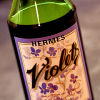


Le Mistral Mauve
1/2oz to 1oz creme de violette
1/2oz rosemary-infused simple syrup, or to taste
Brut Champagne or other dry sparkling wine
Measure the violette and rosemary syrup into a Champagne flute. Top with a dry bubbly, and garnish with a blossoming herb. (We used rosemary, but any pretty sprig will do.)
To make rosemary syrup, measure equal parts water and sugar into a saucepan. Bring to a simmer over medium-low heat, and stir occasionally until sugar is completely dissolved. Add a large bunch of rosemary to the pan, and remove from the heat. Allow the rosemary to steep in the syrup until its flavor is very pronounced. Remove the rosemary, and strain the syrup through a fine sieve (or a coffee filter, if you want to be fancy).
I usually add a fresh sprig of rosemary to the syrup bottle; it reminds me what’s inside, and has the side effect of looking rather charming. Flavored syrup keeps in the refrigerator for at least a week. Other drinks that use rosemary syrup include the Gin-Gin Cooler and the Rosemary Five; It’s also lovely in sparkling water as a homemade soda.
EDITED TO ADD: If you can’t find creme violette in your area, Monin makes a lovely non-alcoholic violet syrup that you can use in its place. Lots of restaurant supply stores sell these syrups, or you can buy them on Amazon.
Drink of the Week, drinks, recipes, wine & bubbly
9 Comments »




Posted by Anita on 01.25.08 10:34 PM
 We haven’t gone in much for New Year’s resolutions this year, but we are making a few small changes. As part of our Dark Days Challenge (and as a side effect of finally finishing reading Omnivore’s Dilemma, two years behind the curve) we’re moving more of our food-budget dollars around. We’d already dabbled a bit in acclimating our palates to grass-fed beef, and we’re going to get more serious about it this coming year.
We haven’t gone in much for New Year’s resolutions this year, but we are making a few small changes. As part of our Dark Days Challenge (and as a side effect of finally finishing reading Omnivore’s Dilemma, two years behind the curve) we’re moving more of our food-budget dollars around. We’d already dabbled a bit in acclimating our palates to grass-fed beef, and we’re going to get more serious about it this coming year.
But possibly the largest change — one that has an effect on something we eat literally every day — is making the switch to pastured eggs. As I mentioned in the comments to our last Dark Days post, I finally decided that spending the extra cash for ethically raised eggs was really not going to put a huge dent in the food budget. But man, $7 a dozen feels extravagant when you’ve been spending $2.25 for quasi-organic eggs.
Which brings me to one of my first food discoveries of the new year: Just because you buy your eggs from a joke-cracking fella at the Ferry Plaza market doesn’t mean they’re ethically raised. (If you get your eggs from Judy’s Family Farm or any of the other eggs at the stand across from June Taylor, do yourself a favor and click that link.) Needless to say, I was pretty pissed off to discover that I’d been duped by what Michael Pollan might call “farmers market pastoral.” It took a dose of righteous anger to open my eyes: A $5-per-week premium isn’t outrageous. It’s a tiny fraction of our food budget, and a drop in the bucket compared to the cost buying of ethically farmed meat.
 With that little surprise under my belt, I reluctantly started digging deeper into the true origins of other items that I’d previously assumed were sustainably produced. Much to my pleasant surprise, Clover Organic and a number of other brands I suspected might be greenwashing were entirely on the level. (I’m not sure whether I was more shocked by my egg supplier’s betrayal or the honesty of one of the area’s largest dairies.)
With that little surprise under my belt, I reluctantly started digging deeper into the true origins of other items that I’d previously assumed were sustainably produced. Much to my pleasant surprise, Clover Organic and a number of other brands I suspected might be greenwashing were entirely on the level. (I’m not sure whether I was more shocked by my egg supplier’s betrayal or the honesty of one of the area’s largest dairies.)
But back to the sunny side: Putting together Dark Days meals continue to feel far too easy. Our summer of canning, salting, freezing, and otherwise preserving the harvest is paying off in spades; sometimes dinner’s as simple as opening the freezer, thawing a bag of protein, and heating up a starch and a farmers market vegetable to go alongside.
We’ve also managed to add a number of new local items to our roster of ingredients. In the first half of the month, we sourced Liberty duck from Sonoma County Poultry (Penngrove – 48 miles); Giusto’s flour and baking soda (South San Francisco – 8 miles), and of course those Eatwell Farm pastured eggs (Dixon – 67 miles).

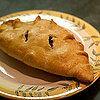



Dark Days Ticker — January 1-15
– Dark Days dinners: 7 (out of 15)
– New recipes: Duck burgers, country-fried steak, Cornish pasties
– Old faves: One-day cassoulet (leftovers)
– Freezer fodder: Chile verde tacos; gravlax; linguine Bolognese; fusilli marinara
Dark Days challenge, locavore, shopping
13 Comments »




Posted by Anita on 01.25.08 7:03 AM
 Last weekend’s do-it-yourself bubbly bar was a source of great amusement for our guests. Aided by a handy cheat-sheet, the crew whipped up Kir Royales and Champagne Cocktails and Death in the Afternoons aplenty. For the teetotalers, we also offered an assortment of homemade syrups and alternative sparklers — Seltzer Sisters soda water and two kinds of ginger ale — along with suggestions for non-alcoholic spritzers.
Last weekend’s do-it-yourself bubbly bar was a source of great amusement for our guests. Aided by a handy cheat-sheet, the crew whipped up Kir Royales and Champagne Cocktails and Death in the Afternoons aplenty. For the teetotalers, we also offered an assortment of homemade syrups and alternative sparklers — Seltzer Sisters soda water and two kinds of ginger ale — along with suggestions for non-alcoholic spritzers.
One of my favorites in this category is the venerable Horse’s Neck, a deceptively simple combination of a ginger ale and long strip of lemon zest that dates to the late 1800s. Popular though the soft drink was, it didn’t take long for clever barkeeps to fortify it. As early as 1897, columnists allowed that “a dash of whisky is said not to interfere with the agreeable taste of this drink.” By the turn of the century, the once-optional shot was nearly a foregone conclusion, although the original recipe enjoyed a revival of sorts during the temperance years.
The boozed-up version — known as a “Horse’s Neck with a Kick” or a “Stiff Horse’s Neck”, depending on which mixology manual you consult — adds an ounce or two of your favorite brown liquor to the glass. Most recipes call for whiskey of some sort, but you find occasional mentions of brandy or even gin. Wander a little further afield, and it’s not too hard to see the hoofprints in similar beverages: Swap rum for whiskey and a lime wedge in place of the lemon twist, and you’ve got a Dark & Stormy. Substitute vodka, and you’re 2/3 of the way to a Moscow Mule — even the name is a clue!





Horse’s Neck with a Kick
1-1/2 to 2oz bourbon or rye
ginger ale
bitters
lemon zest
Place a long, continuous spiral of lemon zest in a Collins glass, hooking one end over the rim to keep it from sinking. Fill the glass with ice, add the bourbon and a few shakes of bitters, and top with ginger ale.
1 Year Ago — DOTW: Bobby Burns
Drink of the Week, drinks, recipes
6 Comments »




Posted by Anita on 01.24.08 2:22 PM
 I may be the only foodie on the planet who doesn’t dig duck. I love the glorious seared breast they’ve been known to serve at Seattle’s Union, and we’ll pick up the occasional leg of confit for salads or cassoulet. I don’t actively dislike it, but duck’s not the kind of food I generally crave.
I may be the only foodie on the planet who doesn’t dig duck. I love the glorious seared breast they’ve been known to serve at Seattle’s Union, and we’ll pick up the occasional leg of confit for salads or cassoulet. I don’t actively dislike it, but duck’s not the kind of food I generally crave.
All that may be changing. On our recent trip to Napa, Cameron ordered the famous duck burger at Cindy’s Backstreet Kitchen. It smelled so heavenly that I had to try a taste. Needless to say, the combination of sweet, spicy, and smoky goodness made a lasting impression on me; as soon as we got home, I flipped open our copy of Big Small Plates to hunt down the details.
I found it easily enough, but the complexity of reproducing this dish was enough to make my eyes roll back in my head. The recipes, plural, went on for pages and pages — and that didn’t even count the marinade found in a separate part of the book. Ugh. But the flavor of that burger was haunting me… and besides, what better way could there be to spend a lazy Saturday afternoon?
Truth be told, the prep wasn’t all that difficult, or even time-consuming. There’s a lot of measuring and mixing, but that’s about it. We weren’t wowed by the original mustard sauce sub-recipe, however; it took too much time, dirtied too many dishes, made enough spread for a dozen burgers, and ended up tasting no better than a much easier substitution: store-bought honey mustard mixed with a touch of creme fraiche.
If you can find pre-ground duck for this recipe, things get even easier; some Whole Foods locations offer it, and any decent butcher should grind duck-leg meat (or any meat you want, for that matter) on request. Bizarrely, the recipe says you need two whole ducks at 4 pounds each — 8 pounds of bone-in duck!? — to make 1 pound of ground meat. Holy duck! Instead, we purchased 4 whole duck legs — about 1-3/4 pounds total weight, before boning — and ran the meat, fat, and a small amount of skin through our KitchenAid grinder. We ended up with exactly 1 pound of ground meat.

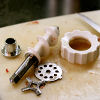
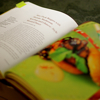
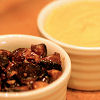

Cindy’s Famous Duck Burgers
– adapted from Big Small Plates
Patties
1 pound ground duck (see note in text above)
1 scallion, white and tender green parts, minced
1 tsp grated fresh ginger
1-1/2 tsp minced garlic
1T Mongolian marinade (see below)
1 tsp salt
1/4 tsp black pepper
Mustard Sauce
2T spicy honey mustard
2T creme fraiche
Shiitake Ketchup
2T olive oil
1 pound shiitake mushrooms, stemmed and quartered
1 onion, diced fine
1/2 tsp salt
1/2 tsp pepper
1/4 cup balsamic vinegar
2 tsp minced garlic
2 T molasses or dark honey
1/4 cup Mongolian marinade (see below)
To Finish
1 cup arugula
3 or 4 egg-sesame hamburger buns
Combine patty ingredients in a large bowl. Refrigerate duck mixture while making remaining components — at least 1 hour, or overnight.
Whisk the honey mustard and creme fraiche in a small bowl. Refrigerate until serving time.
Saute the mushrooms in a skillet with the oil over medium-high heat, cooking until tender. Add the onions and cook until translucent. Add the remaining ingredients, stirring well to combine, and simmer 3 to 5 minutes, until the sauce coats the mushrooms.
Portion the meat into 1/4- to 1/3-pound patties. Grill the burgers over a medium-hot fire, or broil in the oven, to medium rare — about 4 minutes on the first side, and 2 on the back — or to taste.
While burgers are cooking, toast the hamburger buns. Spread some of the mustard sauce on the bottom half of the bun. Top with the cooked burger, then the shiitake ketchup and arugula. Top with the other bun half, and serve.
—–
Mongolian Marinade
1/3 cup hoisin sauce
1-1/2 tsp sugar or honey
2 tsp tamari
2 tsp sherry vinegar
1 medium scallion, white and light green parts, minced
1/2 tsp Tabasco sauce
1/2 tsp black bean chili paste
1 tsp grated fresh ginger
2 tsp minced garlic
1/4 to 1/2 tsp ground white pepper
2T minced cilantro
1-1/2 tsp sesame oil
Whisk all ingredients together and set aside.
(Leftover marinade keeps for 3 to 6 months in the freezer, and works well on chicken or pork chops, too.)
cookbooks, locavore, recipes
10 Comments »




Posted by Anita on 01.18.08 7:09 AM
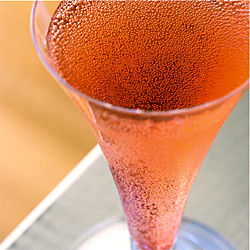 In the pantheon of sparkling cocktails, there are a thousand lesser gods, and then there are the titans: the bright Mimosa, the elegant Champagne cocktail, the tart French 75, and the dusky Kir Royale. They’re generally a subtle lot, and so simple to make that you hardly need a recipe. They’re all lovely in their own ways and moods — Mimosas at brunch, Champagne cocktails at weddings, French 75s when you want to get into an argument about gin vs. brandy — but the Kir Royale is perhaps the most adaptable.
In the pantheon of sparkling cocktails, there are a thousand lesser gods, and then there are the titans: the bright Mimosa, the elegant Champagne cocktail, the tart French 75, and the dusky Kir Royale. They’re generally a subtle lot, and so simple to make that you hardly need a recipe. They’re all lovely in their own ways and moods — Mimosas at brunch, Champagne cocktails at weddings, French 75s when you want to get into an argument about gin vs. brandy — but the Kir Royale is perhaps the most adaptable.
Until it was popularized by Catholic priest Félix Kir, the simple aperitif of white wine and blackcurrant liqueur was known quite aptly as blanc-cassis throughout its native Burgundy. But then, history intervened. An active organizer in the Resistance during World War II, Monsieur Kir helped plan the escape of more than 5,000 prisoners of war. After the Liberation, Kir was elected mayor of Dijon — the Burgundian capital — and eventually took his place in the French national assembly. He was the last clergy member to wear the habit in the halls of the Palais Bourbon, and he always toasted delegations visiting Dijon with the aperitif that perfectly marries two of the town’s best tipples.
The original Kir is made by dosing white wine — not, as some would say, Burgundy’s reknowned Chablis, but rather the slightly sour Aligoté — with Dijon’s equally famous blackcurrant liqueur, creme de cassis. The Kir Royale makes things a bit more festive by replacing the white wine with Champagne, an inspired substitution that moves an everyday apero into the realm of celebratory cocktail.
The Kir Royale also makes a perfect party drink, as it’s low in alcohol — best for guests who may not be accustomed to knocking back a few high-octane libations in an evening — and quite forgiving of measurement-free mixing. After all, what host wants to spend time fiddling with precisely a half-ounce of this and exactly three shakes of that when there are guests to greet, coats to hang, conversation to encourage, and appetizers to primp?
We’re having a few friends over for cocktails and canapés tomorrow night, and one of the ways we’re planning to keep things simple is by setting up a do-it-yourself Champagne bar. We’ll put a case of bubbly on ice, line up a couple dozen flutes, and gather a gaggle of colorful liqueurs — cassis, St-Germain, absinthe, violette, Chartreuse — for guests to customize their drinks. We’ll have syrups, garnishes, and bitters, too, plus a sheet with ideas on how to mix and match. It’ll be fun to see an assortment of pastel sparklers in the hands of our pals; I can’t wait to see what our clever friends concoct.






Kir Royale
1/4 to 1/2 ounce crème de cassis (or to taste)
Champagne or other dry sparkling wine
Pour the cassis into the flute, and top with the bubbly.
Garnish with a lemon twist, if desired.
Drink of the Week, drinks, entertaining, recipes, wine & bubbly
20 Comments »




Posted by Anita on 01.13.08 2:08 PM
 Suffice to say that we had such a relaxing time on our vacation that it’s taking us an inordinately long time to get back in the swing of things. We’ve been home nearly 2 weeks now, and I am finally getting my head out of the clouds long enough to tell you about all the gorgeous food we ate.
Suffice to say that we had such a relaxing time on our vacation that it’s taking us an inordinately long time to get back in the swing of things. We’ve been home nearly 2 weeks now, and I am finally getting my head out of the clouds long enough to tell you about all the gorgeous food we ate.
Our 10 days away — in a little cottage in the foothills above Napa Valley — were incredibly relaxing. We brought along two coolers full of food from the farmers market (our landlord eyed the back of our car and quipped, “You know, we do have grocery stores here…”) and we spent nearly every day sitting by the fire, catching up on our reading, and cooking amazing food.
The day we drove up, we bought a pair of enormous Dungeness crabs from Shogun fish on their last market day of the season. The first night in our little cottage, Cameron picked the crabs and we sauteed the meat in Spring Hill Farm butter along with some zest from our backyard lemons and a few slices of green onions. Served over Eduardo’s linguine, with a salad and a split of Schramsberg sparkling wine, it was the perfect settling-in meal.
Of course, there was plenty of leftover crab meat! The next day, we turned part of it into crab omelettes for brunch, then mixed the rest into a sumptuous batch of fondue mac-and-cheese. Monday night, we whipped up a 100% local batch of Jen’s chicken cacciatore with an heirloom chicken from Prather and some Far West Funghi chanterelles, served over Full Belly Farm polenta with a bottle of Calistoga Cellars Zinfandel.
Tuesday night was Christmas supper: Mini beef Wellingtons! Prather Ranch filet mignon wrapped in puff pastry with a slice of Fatted Calf foie gras and duxelles made from Far West cremini mushrooms, Spring Hill butter, and Straus cream. On the plate: A sauce of red-wine-infused demiglace (homemade from Prather bones) and a side of Iacopi green beans quick-braised with Fatted Calf pancetta. We drank a bottle of Cabernet from Mount Veeder Winery, just a few miles down the road from our cottage.
Wednesday night, we turned to our usual lazy-day standby: Pasta Bolognese with a big green salad. Thursday we took the night off from kitchen duty, and headed down the hill for a gorgeous sushi-fest at Go Fish. By Friday, we were ready to cook again: We pulled the last of our homemade spiral sausage out of the freezer and served it along with cauliflower soup made from farmers market veggies and a mixture of orphan pieces from the local cheese plate we’d been nibbling all week.
Saturday night Cameron made an improvised braise of Prather beef cheeks, with homemade beef stock, home-canned tomatoes, and herbs from the garden. Served with more Full Belly polenta and some Ella Bella broccoli rabe, it was the perfect supper for the chilliest night of our trip.
Sunday night, we began prepping our traditional New Year’s cassoulet. While the stovetop was occupied simmering Rancho Gordo beans, searing Toulouse sausages, and cooking off Fatted Calf duck confit, we used the oven to roast a most gorgeous Range Brothers pork rib roast. An unorthodox recipe for potato gratin — started on the stovetop and finished in the oven while the roast rested — turned out beautifully… a perfect showcase for Little’s potatoes, Bellwether Farms cheese, and Clover dairy. We usually roast our Brussels sprouts, but because our baby oven couldn’t accommodate a roast and a side dish, we tried a new-to-us method: Sauteeing the shredded sprouts in rendered pancetta fat, and adding the crisped pork back to the finished dish at the end. (We loved it so much, we’re having it again tonight.)
Monday night — New Year’s eve — meant it was finally time to break into the cassoulet that had been tempting us with its luscious smells for the last 24 hours. A rough-but-tasty bottle of Pinot Noir and a big salad were all we needed to round out its delicious pork-infused goodness.
Packing the next morning was almost impossibly hard; our little kitchen had served us so well for our 10 days away! Unlike most rental houses, this one was well stocked with high-end cookware and thoughtful staples (organic eggs and Bouchon pastries awaited us our first morning). But the ultimate luxury was having the time to putter in the kitchen all day, every day. The space was cozy, and the equipment a bit spare, but it was such a treat to forget about the office, the phone, and all of our usual distractions for a few days and cook together.
We planned all along to keep up with the Dark Days challenge while we were gone, but looking back over our photos, we were surprised at just how well we’d done. With the exception of cocktails, a few lunches out, and our one in-town dinner, everything we ate and drank during our trip came from local sources. Getting to the 90% local, five-nights-a-week mark has become pretty achievable for us on a regular basis. It’s comforting to know we could get to 100% local — given unlimited time to plan, to shop, to cook — even if it’s not something we’re able to do in the workaday world.

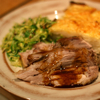

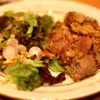

Now, in theory, the Dark Days challenge wrapped up at the end of last year, with an optional extension into 2008. We’re having such a ball, we’ve decided to continue with the challenge, along with more than 20 other participants. Because our hostess, Laura, is in the midst of moving her house (and her chickens!), official wrap-ups will taper off to every two weeks.
Because it’s a new year, we’re going to make some changes to our own ground rules, too. Here’s our revised game-plan:
- We will continue to cook locally as often as we can, with a baseline of two dinners per week made from 90% local ingredients.
- We will write about
at least two meals a week made with as many local ingredients as we can source. our locavore adventures regularly, but we’re going to dispense with the litany of meals and sources, as it’s getting rather repetitious and a bit boring for non-locavore readers. We WILL talk about new pantry items, new farmers we’ve discovered, and recipes for in-season items within our foodshed.
- Local for us will be a 100-mile radius for produce and a 200-mile radius for protein. We will try to keep our protein within a 50- to 100-mile radius at least twice a week. Strong preference will be given to items purchased directly from farmers at market rather than retail. Our protein will include pastured eggs, poultry, and pork, as well as grass-fed beef. When grass-fed is not available or not appropriate, we will use 100% humanely raised, pastured beef. (I find grass-fed beef too gamey in grilled or stir-fried preparations, but for braises and stews, it’s our new default.)
- We’re making the usual ‘Marco Polo’ exemptions for seasonings.
We’re also making exceptions for flour, dried pasta, white rice, and polenta — we have no local sources of these ingredients, and man does not live by potatoes and bread alone. We will try to source baking ingredients locally, but I don’t expect to find much beyond nuts, and I won’t go through the holidays without baking. (We’ve found local sources for all of our grains.)
- We’ll try to limit processed and prepared foods to those produced within a 50-mile radius. We’ll try to determine how much local ingredient sourcing they’re doing, and talk about it in our posts.
- We’ll continue with the challenge through the end of
the year, and then re-evaluate on New Year’s Day along with other participants. March.
Dark Days challenge, locavore, Napa & Sonoma, travel
6 Comments »




Posted by Anita on 01.11.08 9:27 PM
 Our fave spot Range has been closed for a post-New Year holiday break so we had no idea anything was amiss. But, tonight we read on 7×7’s Buzzed blog that head bartender Brooke Arthur has been hospitalized since New Year’s Eve due to severe smoke inhalation and burns, the result of a fire in her apartment.
Our fave spot Range has been closed for a post-New Year holiday break so we had no idea anything was amiss. But, tonight we read on 7×7’s Buzzed blog that head bartender Brooke Arthur has been hospitalized since New Year’s Eve due to severe smoke inhalation and burns, the result of a fire in her apartment.
Although she probably wouldn’t know us from Adam, Brooke’s amazing cocktail program is one of the many reasons we spend an inordinate amount of our dining budget at Range every month; we even featured one of her creations on Drink of the Week last summer.
In addition to some mind-bending hospital bills — she’s in an intensive burn unit, and unable to breathe on her own at this point, according to the page her family’s updating — Brooke also lost most everything in her apartment to the fire. Duggan and the boys at Cantina are hosting a benefit for Brooke’s expenses this coming Monday night. If you’re a fan of Range’s bar program, or even if you need a worthy excuse for an early-in-the-week cocktail, please join us there.
If you’re unable to come, or simply prefer to donate to Brooke’s family directly, please visit Brooke’s site.
—–
UPDATE 1/15: Last night’s benefit at Cantina was a jam-packed success. Even better news from Marcia at Tablehopper: A star-studded cast of Range alums — including Dominic and Camber — are picking up Brooke’s shifts while she’s convalescing. On Tuesdays and Thursdays (yay, our regular nights!) the restaurant will match all bar tips, donating them to a fund for Brooke’s medical bills and lost income.
bar culture, giving back, other stuff
1 Comment »




 Have I mentioned lately how much I love the farmers who keep us fed? Even when I’ve done something utterly short-sighted, they managed to swoop in and save me from my own culinary stupidity.
Have I mentioned lately how much I love the farmers who keep us fed? Even when I’ve done something utterly short-sighted, they managed to swoop in and save me from my own culinary stupidity.



































 Last weekend’s
Last weekend’s 






















 Our fave spot Range has
Our fave spot Range has 